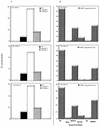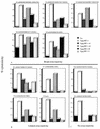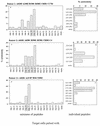Cytotoxic T cells from human immunodeficiency virus type 2-infected patients frequently cross-react with different human immunodeficiency virus type 1 clades
- PMID: 9499105
- PMCID: PMC109544
- DOI: 10.1128/JVI.72.3.2439-2448.1998
Cytotoxic T cells from human immunodeficiency virus type 2-infected patients frequently cross-react with different human immunodeficiency virus type 1 clades
Abstract
Knowledge of immune mechanisms responsible for the cross-protection between highly divergent viruses such as human immunodeficiency virus type 1 (HIV-1) and HIV-2 may contribute to an understanding of whether virus variability may be overcome in the design of vaccine candidates which are broadly protective across the HIV subtypes. We demonstrate that despite the significant difference in virus amino acid sequence, the majority of HIV-2-infected individuals with different HLA molecules possess a dominant cytotoxic T-cell response which is able to recognize HIV-1 Gag protein. Furthermore, HLA-B5801-positive subjects show broad cross-recognition of HIV-1 subtypes since they mounted a T-cell response that tolerated extensive amino acid substitutions within HLA-B5801-restricted HIV-1 and HIV-2 epitopes. These results suggests that HLA-B5801-positive HIV-2-infected individuals have an enhanced ability to react with HIV-1 that could play a role in cross-protection.
Figures









Similar articles
-
Cross-reactions between the cytotoxic T-lymphocyte responses of human immunodeficiency virus-infected African and European patients.J Virol. 1998 May;72(5):3547-53. doi: 10.1128/JVI.72.5.3547-3553.1998. J Virol. 1998. PMID: 9557634 Free PMC article.
-
Identification and characterization of HLA-A*3303-restricted, HIV type 1 Pol- and Gag-derived cytotoxic T cell epitopes.AIDS Res Hum Retroviruses. 2003 Jun;19(6):503-10. doi: 10.1089/088922203766774559. AIDS Res Hum Retroviruses. 2003. PMID: 12882660
-
Comprehensive screening for human immunodeficiency virus type 1 subtype-specific CD8 cytotoxic T lymphocytes and definition of degenerate epitopes restricted by HLA-A0207 and -C(W)0304 alleles.J Virol. 2002 May;76(10):4971-86. doi: 10.1128/jvi.76.10.4971-4986.2002. J Virol. 2002. PMID: 11967314 Free PMC article.
-
Cytotoxic T lymphocytes recognize structurally diverse, clade-specific and cross-reactive peptides in human immunodeficiency virus type-1 gag through HLA-B53.Eur J Immunol. 2001 Jun;31(6):1747-56. doi: 10.1002/1521-4141(200106)31:6<1747::aid-immu1747>3.0.co;2-l. Eur J Immunol. 2001. PMID: 11385619
-
Identification of highly conserved and broadly cross-reactive HIV type 1 cytotoxic T lymphocyte epitopes as candidate immunogens for inclusion in Mycobacterium bovis BCG-vectored HIV vaccines.AIDS Res Hum Retroviruses. 2000 Sep 20;16(14):1433-43. doi: 10.1089/08892220050140982. AIDS Res Hum Retroviruses. 2000. PMID: 11018863 Review.
Cited by
-
Hierarchical targeting of subtype C human immunodeficiency virus type 1 proteins by CD8+ T cells: correlation with viral load.J Virol. 2004 Apr;78(7):3233-43. doi: 10.1128/jvi.78.7.3233-3243.2004. J Virol. 2004. PMID: 15016844 Free PMC article.
-
HLA and disease.Eur J Epidemiol. 2005;20(6):475-88. doi: 10.1007/s10654-005-5081-x. Eur J Epidemiol. 2005. PMID: 16121756 Review.
-
Prime-boost immunization of codon optimized HIV-1 CRF01_AE Gag in BCG with recombinant vaccinia virus elicits MHC class I and II immune responses in mice.Immunol Invest. 2009;38(8):762-79. doi: 10.3109/08820130903070544. Immunol Invest. 2009. PMID: 19860587 Free PMC article.
-
Regulation of HIV-Gag expression and targeting to the endolysosomal/secretory pathway by the luminal domain of lysosomal-associated membrane protein (LAMP-1) enhance Gag-specific immune response.PLoS One. 2014 Jun 16;9(6):e99887. doi: 10.1371/journal.pone.0099887. eCollection 2014. PLoS One. 2014. PMID: 24932692 Free PMC article.
-
HIV-2 inhibits HIV-1 gene expression via two independent mechanisms during cellular co-infection.J Virol. 2023 Dec 21;97(12):e0187022. doi: 10.1128/jvi.01870-22. Epub 2023 Nov 22. J Virol. 2023. PMID: 37991365 Free PMC article.
References
-
- Aaby P, Poulsen A-G, Larsen O, Christiansen C B, Jensen H, Melbye M, Naucler A, Dias F. Does HIV-2 infection provide cross-protection against HIV-1 infection? AIDS. 1997;7:939–940. . (Letter.) - PubMed
-
- Abimiku A G, Franchini G, Tartaglia J, Aldrich K, Myagkikh M, Markham P D, Chong P, Klein M-P, Kieny M, Paoletti E, Gallo R C, Robert-Guroff M. HIV-1 recombinant poxvirus vaccine induces cross-protection against HIV-2 challenge in rhesus macaques. Nat Med. 1995;1:321–329. - PubMed
-
- Anderson R W, Bennick J R, Yewdell J W, Maloy W L, Coligan J E. Influenza basic polymerase 2 peptides are recognized by influenza nucleoprotein-specific cytotoxic T lymphocytes. Mol Immunol. 1992;29:1089–1095. - PubMed
-
- Ariyoshi K, Cham F, Berry N, Jaffar S, Sabally S, Corrah T, Whittle H. HIV-2-specific cytotoxic T-lymphocyte activity is inversely related to proviral load. AIDS. 1995;9:555–559. - PubMed
Publication types
MeSH terms
Substances
LinkOut - more resources
Full Text Sources
Medical
Research Materials

